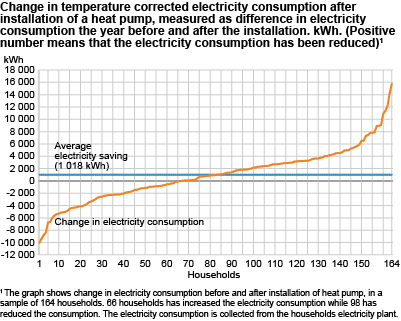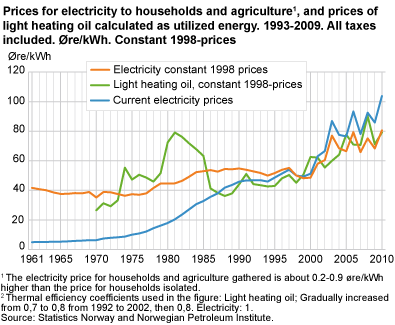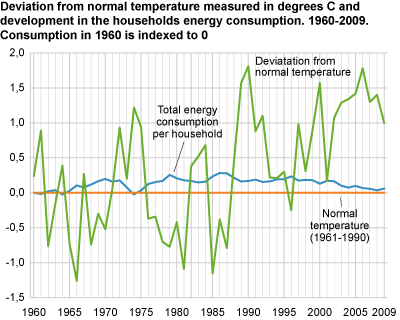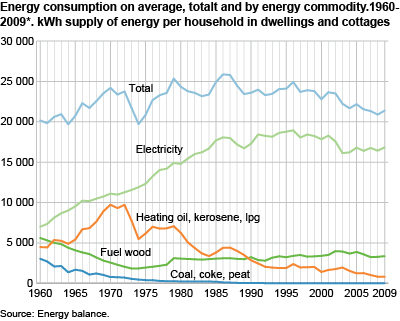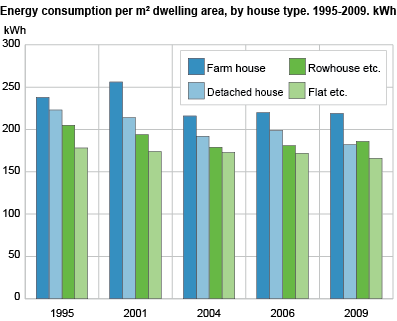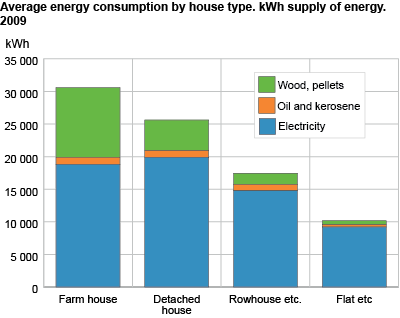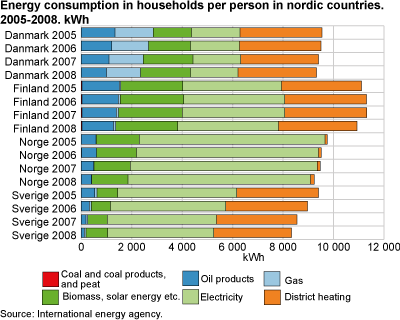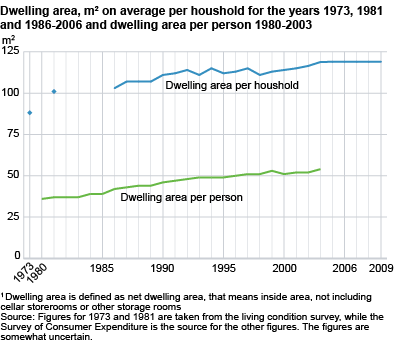Content
Published:
This is an archived release.
Major increase in the use of heat pumps
18.5 per cent of all households had a heat pump in 2009. For detached dwellings, this share was 33 per cent.
The use of heat pumps has increased considerably compared to earlier similar surveys. For comparison, only 8 per cent of households had a heat pump in 2006 and 4 per cent in 2004.
Higher electricity prices can explain the increase
The fact that heat pumps have become more popular could be attributed to the large rise in electricity prices, especially after 2000. While we historically have been used to some of the lowest electricity prices in Europe, we paid between 80 øre and NOK 1 per kWh in the years 2008-2010. This is about the same level as other European countries.
Heat pump may give higher electricity consumption
In the survey on energy consumption in households for 2009, a question was included on the households’ subjective opinion on the effect of heat pumps. About 11 per cent answered that their electricity consumption had increased after the installation of the heat pump, while 22 per cent had not noticed any difference in the electricity consumption. 58 per cent answered that their electricity consumption had been reduced.
Data material from the households’ electricity suppliers on electricity consumption in the years before and after the installation of the heat pumps shows that about 40 per cent have increased their electricity consumption while about 60 per cent have reduced it. The figures have been corrected for differences in temperature. The data also shows that some households who claim that they have reduced their electricity consumption have in fact increased it. This could be due to the fact that most people don’t have a good overview of their own electricity consumption.
The results from the electricity companies show however, that the electricity saving varies considerably between people. Some save a lot, while others increase their consumption, and due to this the average electricity saving becomes modest. There may, however, be some uncertainty in the results for consumption before and after the heat pump installation.
Heat pump changes the behaviour in the households
There could be numerous reasons why the electricity consumption increases when people install a heat pump. One reason is that many reduce their consumption of firewood or oil. This is because a heat pump is more practical, and because electricity for heating purposes in reality becomes cheaper. Around 57 per cent claim that they use less firewood than earlier, and 7 per cent answer that they use less oil. Changes in behaviour are also important for the total saving. About 25 per cent said that they increased their room temperature, while 33 per cent answered that they heat more rooms than before they got the heat pump. About 25 per cent use it for cooling in the summertime. The answers indicate that many wish to increase the comfort when they purchase the heat pump. The effect of cheaper electricity will probably contribute to this.
Outside and inside temperature influences the effect
Both the outside and inside temperature are important. The warmer it is inside, and the colder and more humid it is outside, the lower the effect of the heat pump. There is a tendency that the heat pumps in households in mild regions have a better effect than those in colder regions. Additionally, lack of service and maintenance can contribute to a lower effect of the heat pump over time.
Even if the electricity consumption is not necessarily lower in households with a heat pump, the results show that consumption of firewood and oil is much lower in households with a heat pump than those without. For dwellings above 150 square metres, the total energy consumption in households with a heat pump was about 11-12 per cent lower than for those without a heat pump in 2009, and energy consumption per square metre of dwelling area was about 15 per cent lower for those with a heat pump. The difference is mainly due to lower consumption of firewood and oil, while the electricity consumption is more equal.
The energy consumption per household is going down
The total energy consumption per household was about 20 400 kWh in 2009, which is 3 per cent lower than in 2004 and 10 per cent lower than in 1993. The electricity consumption in 2009 was a mere 16 000 kWh.
The consumption of heating oil decreased most, with a 46 per cent drop from 2004. The oil consumption per household was about 845 kWh in 2009, and made up only 4 per cent of our total energy consumption. Electricity is our most important energy commodity and made up 78 per cent of the energy consumption in 2009, while firewood made up 17 per cent.
Figures for energy consumption in households from the annual energy balance also show a significant drop in oil consumption, and that electricity consumption made up about 16 000 kWh per household in 2009. The consumption per household has had a descending tendency since the mid-1990s, probably due to improvements in dwelling standards and more insulation in newer dwellings. More people in new dwellings (from about 1990) report that the insulation is good compared to those who live in older dwellings. Higher energy prices have also stimulated more energy saving.
Temperature is important
In addition, it has been warmer than normal almost every year since the end of the 1980s. In 2009, the temperature was about 1oC above the normal temperature for the period 1961-1990. If the temperature had been “normal”, it is estimated that the total average energy consumption would have been about 21 000 kWh in 2009.
Large variation in energy consumption among different dwelling types
The energy consumption varies considerably among different dwelling and household types. Households in detached houses and farm houses use much more energy than those who live in flats. In 2009, the average energy consumption in a detached house was about 25 700 kWh. In a farm house the average energy consumption was about 30 600 kWh, while households in a flat used only about 10 500 kWh. This is related to the fact that detached houses have a larger dwelling area, and that more persons are generally living there. The energy consumption per household in detached houses is also higher than in flats, which could be due to a higher dwelling area per person. In addition, there are more outer walls in detached houses than in flats and more loss of energy than in flats, which are surrounded by other flats.
The high energy consumption in farm houses could also be related to the fact that they are old. About 34 per cent of the farm houses in the sample were built before 1931. The average building year for a farm house is 1936, while it is about 1970 for other house types.
Households in Hedmark and Oppland use most energy
The energy consumption is highest in Hedmark and Oppland, with an average consumption of around 26 600 kWh in 2009. This is partly due to the fact that it is colder here than in the rest of the country, and people living here have relatively large houses. Households in Oslo use least energy on average because there are more single people here, and a high share of flats. The average dwelling area in Oslo was about 85 m2, while the average for the country as a whole was about 119 m2.
Fewer households have a stove for oil
The share of households that either has an oil stove or combined stove for oil and firewood has been reduced from 19 per cent in 2006 to 14 per cent in 2009. The share with a stove only for oil has been reduced even further, with a drop from 16 per cent in 2006 to 5 per cent in 2009. About 72 per cent of all households have the possibility to heat with firewood, either in a combined stove or in a stove for firewood only. This share had been rather constant over time. For detached houses, more than 90 per cent can heat with firewood. About 17 per cent have an ambient air heat pump, while almost 2 per cent had another kind of heat pump (geothermal or ground-source heat pump). About 8 per cent have common or individual central heating and this share has also been rather constant in recent years. About 15 per cent used a heat pump as a main heating source in 2009, while 48 per cent used electric stoves as the main heating source. International comparisons show that Norwegian households are among those who use most electricity for heating. In other Nordic countries, it is more usual to use district heating.
Temperature correctionThe energy consumption per household is corrected for temperature by multiplying the temperature dependant energy consumption by the normal degree days for the period 1971-2000 in the households’ municipality, and dividing by the current heating degree day in 2009. This is the same method that is used by the International Energy Agency and Enova, among others. We have assumed that all energy commodities except electricity are mainly used for heating purposes. For electricity we have calculated the heating share by assuming that 50 per cent of all energy consumption is used for heating purposes. We have calculated the heating share of electricity on the basis of the households’ remaining energy consumption, so the heating share in the total energy consumption becomes 50 per cent. See table 5 for more information about the heating degree days. |
Tables:
- Table 1 Average energy consumption, total and by energy commodity. 1993-1995, 2001, 2004, 2006 and 2009. kWh energy supply per household
- Table 2 Average specific energy consumption, total and by energy commodity. 1993-1995, 2001, 2004, 2006 og 2009. kWh supply of energy per m2 dwelling area per household
- Table 3 Average energy consumption by housetype, household size and net income, total and per m2 dwelling area . kWh supply of energy per household. 1995, 2001, 2004, 2006 og 2009
- Table 4 Consumption of different energy commodities by housetype and household size. Supply of energy per household on average and confidence intervals for energy consumption. 2009
- Table 5 Average energy consumption, by year of construction, region and dwelling area. kWh supply of energy per household. 1995, 2001, 2004, 2006 og 2009
- Table 6 Average energy consumption by house type, year of construction and region. kWh utilized energy per household.1995, 2001, 2004, 2006 og 2009
- Table 7 Households with different kinds of heating equipment. 2001, 2004 and 2006. Per cent
- Table 8 Households by heating equipment combinations for 2001, 2004, 2006 og 2009, by dwelling type. Per cent
- Table 9 Energy consumption in dwellings and cottages. 1990-2009. kWh
- Table 10 Energy consumption on average, for households with and without heat pump. kWh energy supply per household. 2004, 2006 og 2009
- Table 11 Households, by main heating source. 2001, 2004, 2009 and 1993-1995 on average. Per cent
Contact
-
Ann Christin Bøeng
E-mail: ann.christin.boeng@ssb.no
tel.: (+47) 40 81 13 58

